Abstract
Recurrent cyanotic episodes associated on some occasions with loss of consciousness due to cerebral hypoxia were investigated by long term tape recordings of breathing activity, oxygen saturation, air flow, electrocardiographic activity, and in some cases electroencephalographic activity. In 51 infants and children the mechanisms for the cyanotic episodes were identified (prolonged expiratory apnoea in 45, sleep related airway obstruction in three, seizure induced apnoea in one, behaviour induced apnoea in one). In one child apnoea was suspected as being caused by suffocation (smothering) by the mother. This was confirmed after enlisting the help of the police, who undertook covert video surveillance during cyanotic episodes. Each cyanotic episode was associated with a pattern of disturbance on the multichannel tape recordings which may be pathognomonic of this type of apnoea. A second infant with cyanotic episodes in whom smothering was suspected was referred for similar investigation after the availability of video recordings became established. Maternal smothering was again supported by specific patterns on multichannel tape recordings and confirmed by video surveillance. Diagnosis by video surveillance produces unequivocal evidence in these cases and avoids the need for medical and nursing staff to confront the mother with a possibly incorrect suspicion or in a court of law.
Full text
PDF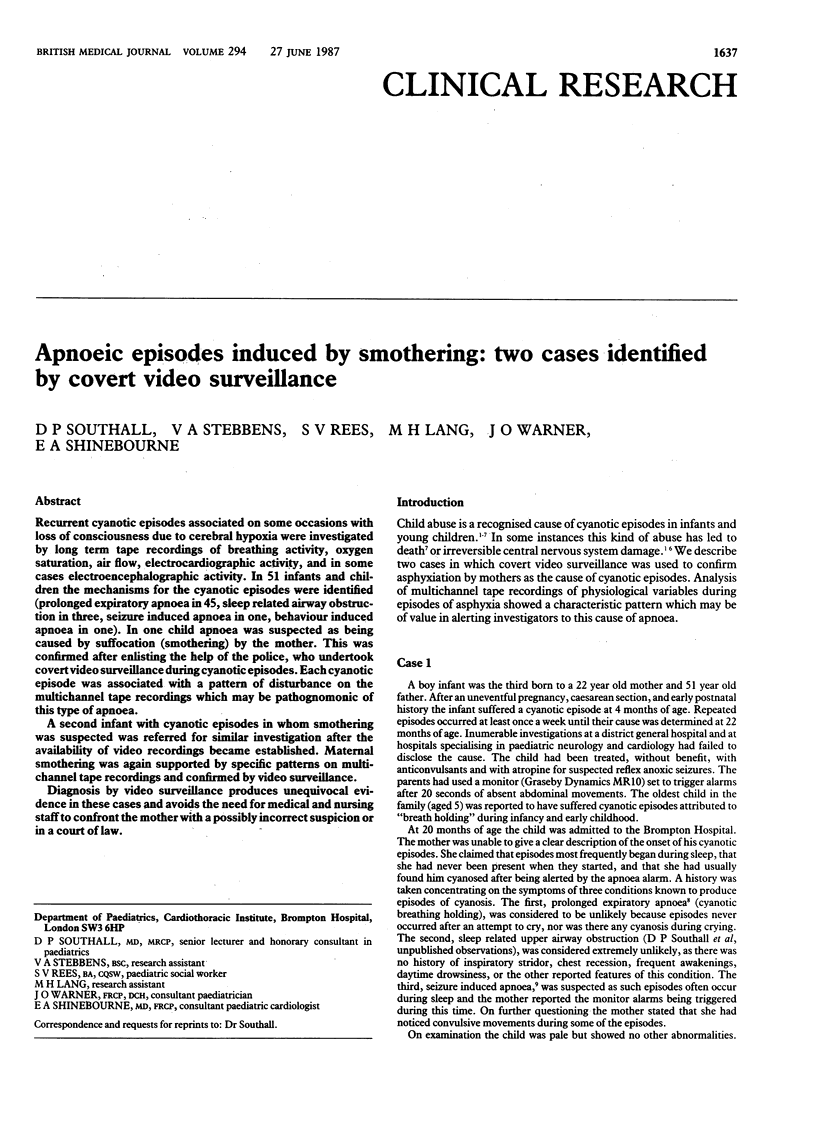
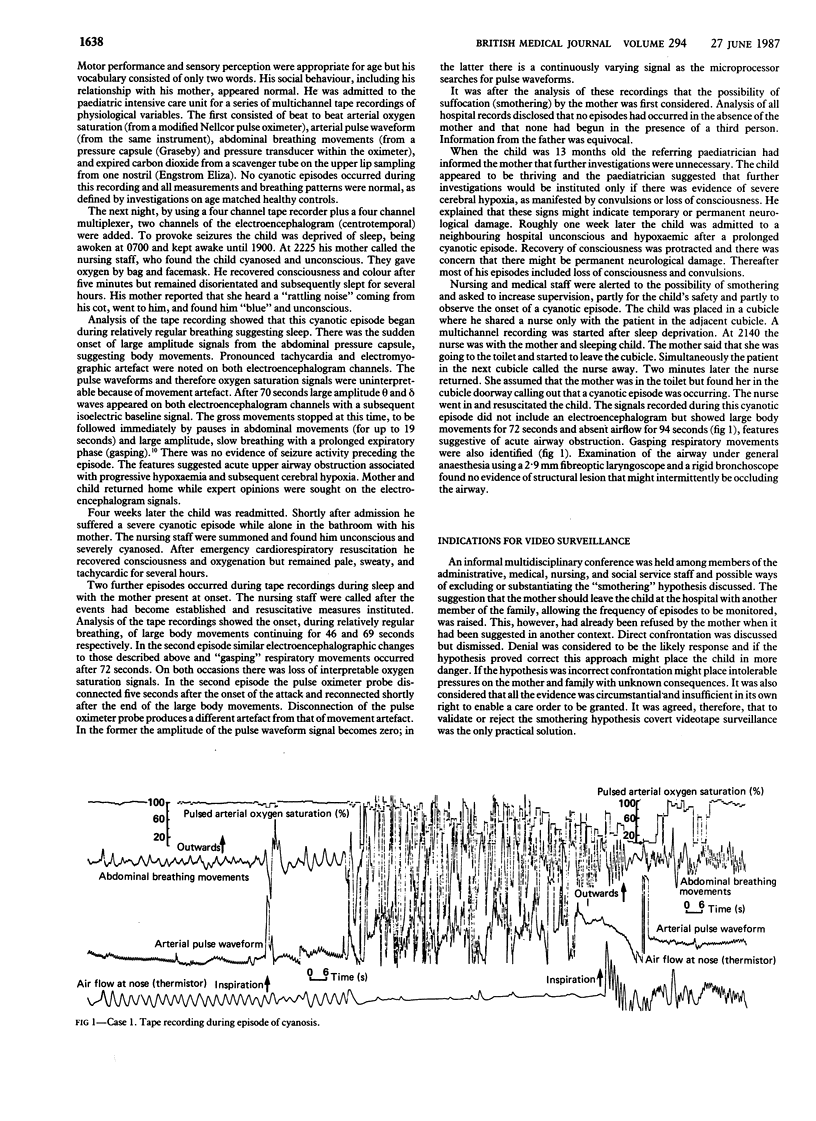
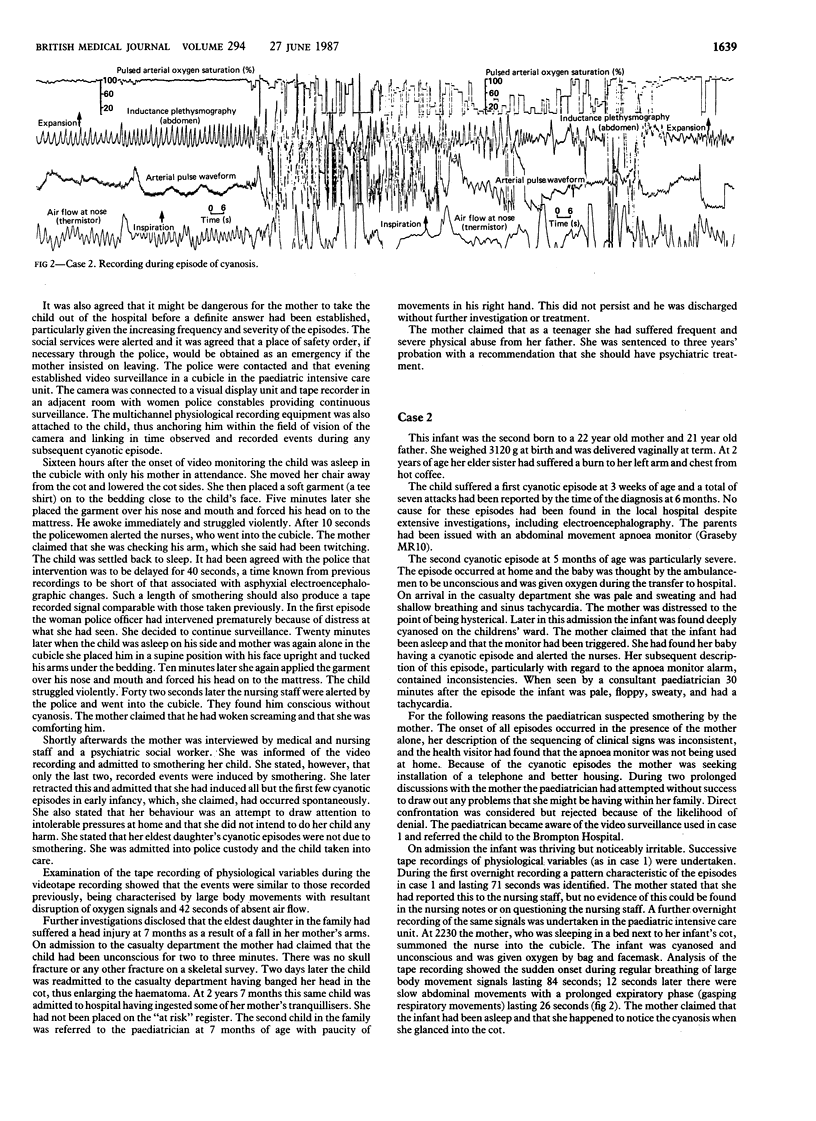
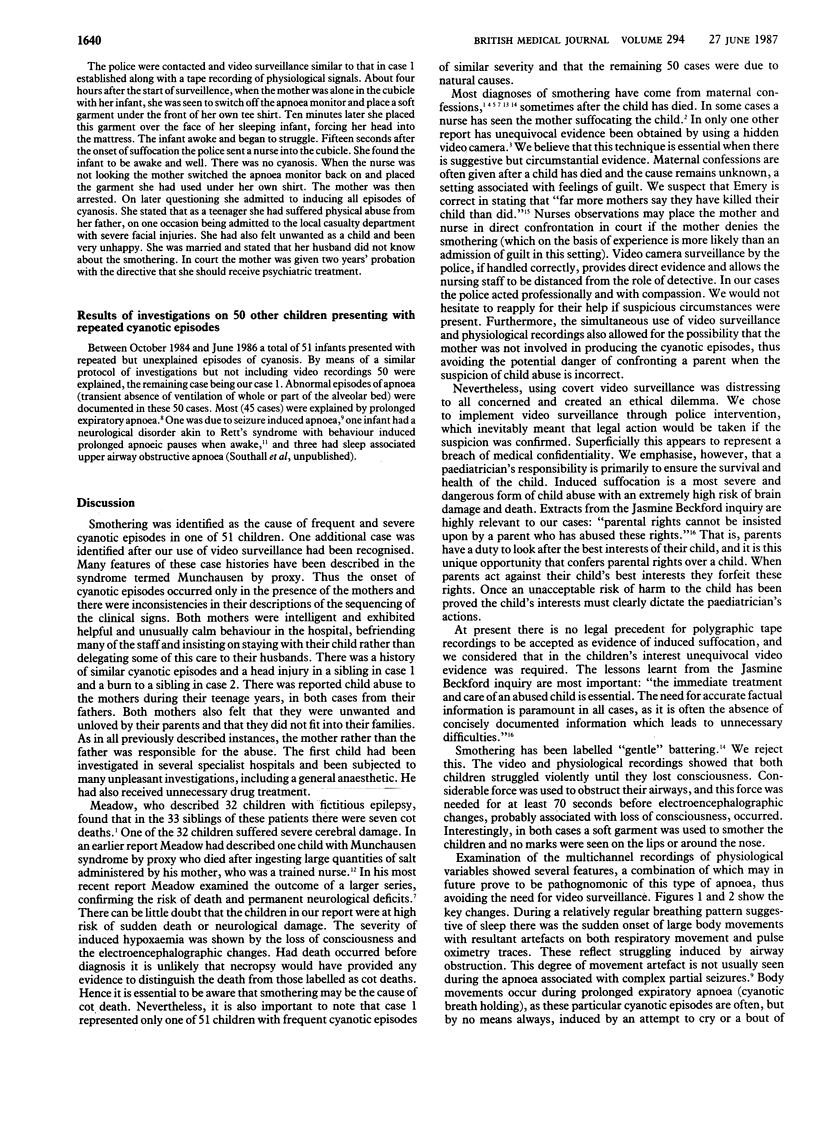
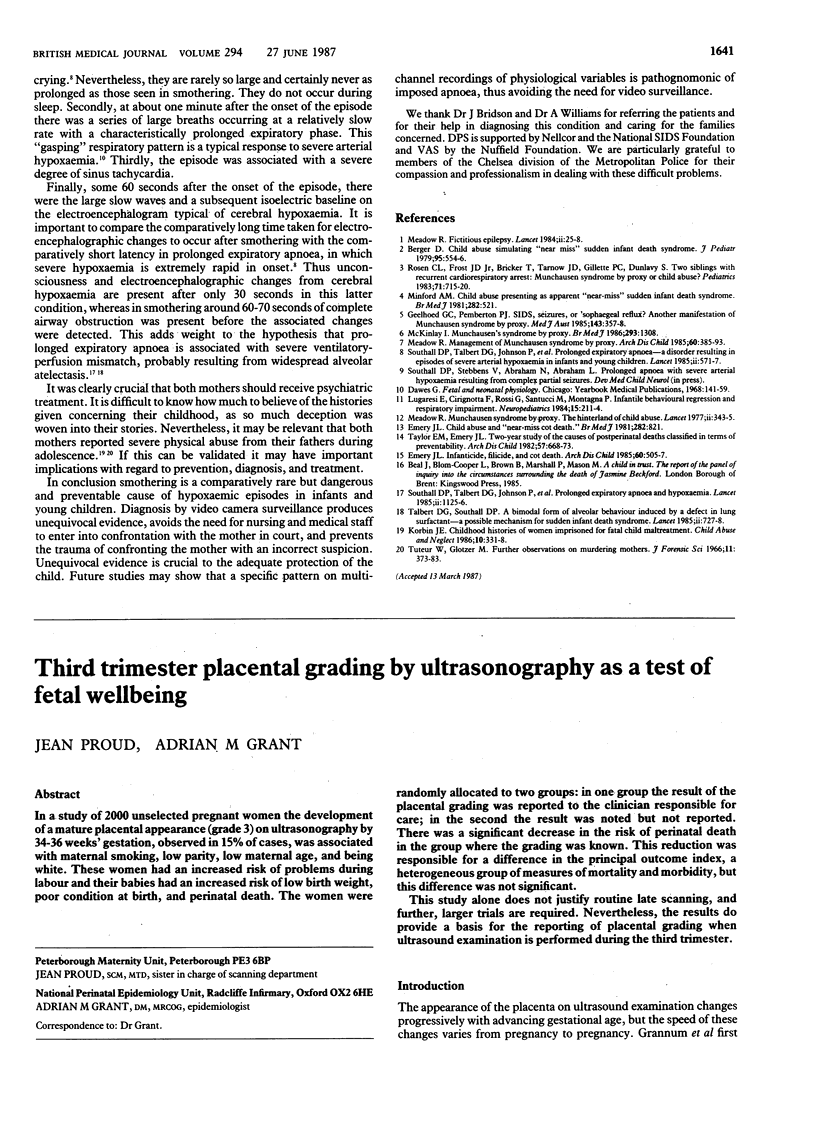
Selected References
These references are in PubMed. This may not be the complete list of references from this article.
- Berger D. Child abuse simulating "near-miss" sudden infant death syndrome. J Pediatr. 1979 Oct;95(4):554–556. doi: 10.1016/s0022-3476(79)80763-5. [DOI] [PubMed] [Google Scholar]
- Colombo M., Mannucci P. M., Carnelli V., Savidge G. F., Gazengel C., Schimpf K. Transmission of non-A, non-B hepatitis by heat-treated factor VIII concentrate. Lancet. 1985 Jul 6;2(8445):1–4. doi: 10.1016/s0140-6736(85)90055-8. [DOI] [PubMed] [Google Scholar]
- Emery J. L. Infanticide, filicide, and cot death. Arch Dis Child. 1985 Jun;60(6):505–507. doi: 10.1136/adc.60.6.505. [DOI] [PMC free article] [PubMed] [Google Scholar]
- Geelhoed G. C., Pemberton P. J. SIDS, seizures or 'sophageal reflux? Another manifestation of Munchausen syndrome by proxy. Med J Aust. 1985 Oct 14;143(8):357–358. [PubMed] [Google Scholar]
- Korbin J. E. Childhood histories of women imprisoned for fatal child maltreatment. Child Abuse Negl. 1986;10(3):331–338. doi: 10.1016/0145-2134(86)90008-6. [DOI] [PubMed] [Google Scholar]
- McKinlay I. Munchausen's syndrome by proxy. Br Med J (Clin Res Ed) 1986 Nov 15;293(6557):1308–1308. doi: 10.1136/bmj.293.6557.1308-a. [DOI] [PMC free article] [PubMed] [Google Scholar]
- Meadow R. Fictitious epilepsy. Lancet. 1984 Jul 7;2(8393):25–28. doi: 10.1016/s0140-6736(84)92008-7. [DOI] [PubMed] [Google Scholar]
- Meadow R. Management of Munchausen syndrome by proxy. Arch Dis Child. 1985 Apr;60(4):385–393. doi: 10.1136/adc.60.4.385. [DOI] [PMC free article] [PubMed] [Google Scholar]
- Meadow R. Munchausen syndrome by proxy. The hinterland of child abuse. Lancet. 1977 Aug 13;2(8033):343–345. doi: 10.1016/s0140-6736(77)91497-0. [DOI] [PubMed] [Google Scholar]
- Minford A. M. Child abuse presenting as apparent "near-miss" sudden infant death syndrome. Br Med J (Clin Res Ed) 1981 Feb 14;282(6263):521–521. doi: 10.1136/bmj.282.6263.521. [DOI] [PMC free article] [PubMed] [Google Scholar]
- Rosen C. L., Frost J. D., Jr, Bricker T., Tarnow J. D., Gillette P. C., Dunlavy S. Two siblings with recurrent cardiorespiratory arrest: Munchausen syndrome by proxy or child abuse? Pediatrics. 1983 May;71(5):715–720. [PubMed] [Google Scholar]
- Southall D. P., Talbert D. G., Johnson P., Morley C. J., Salmons S., Miller J., Helms P. J. Prolonged expiratory apnoea: a disorder resulting in episodes of severe arterial hypoxaemia in infants and young children. Lancet. 1985 Sep 14;2(8455):571–577. doi: 10.1016/s0140-6736(85)90583-5. [DOI] [PubMed] [Google Scholar]
- Talbert D. G., Southall D. P. A bimodal form of alveolar behaviour induced by a defect in lung surfactant--a possible mechanism for sudden infant death syndrome. Lancet. 1985 Mar 30;1(8431):727–728. doi: 10.1016/s0140-6736(85)91266-8. [DOI] [PubMed] [Google Scholar]
- Taylor E. M., Emery J. L. Two-year study of the causes of postperinatal deaths classified in terms of preventability. Arch Dis Child. 1982 Sep;57(9):668–673. doi: 10.1136/adc.57.9.668. [DOI] [PMC free article] [PubMed] [Google Scholar]
- Tuteur W., Glotzer J. Further observations on murdering mothers. J Forensic Sci. 1966 Jul;11(3):373–383. [PubMed] [Google Scholar]


